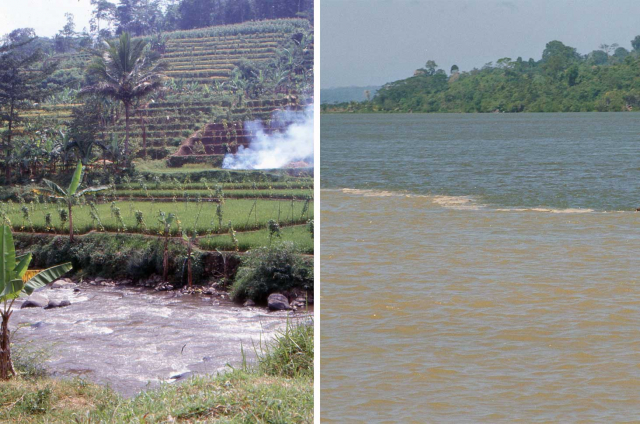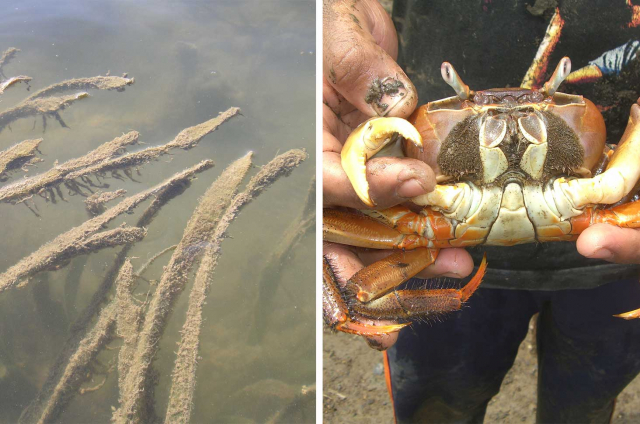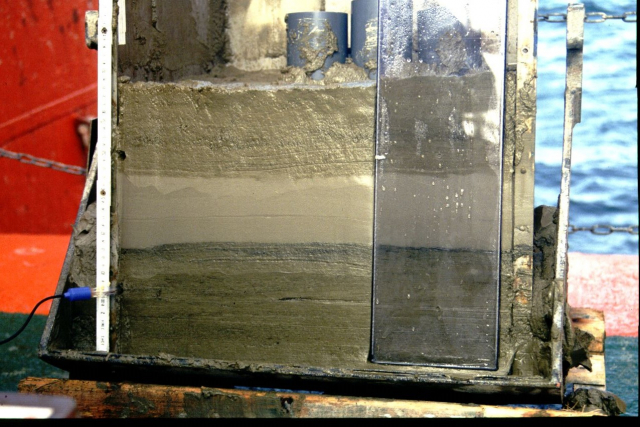Tropical coastal zones receive major part of the annual riverine inputs of freshwater and dissolved and particulate substances. They harbour some of the most productive and diverse ecosystems on earth like coral reefs, seagrasses and mangroves. Besides that they are also among the regions with the strongest human modifications. We investigate the biogeochemical and ecological response of tropical coastal systems to present and past environmental change along four major lines of research.
Moreover, we are engaged in improving the societal use of research results through establishing an interface and a dialogue between science and society. We initiate and conduct a variety of activities with stakeholders from policy and society (currently in project TICAS) that contribute to a sustainable use of tropical coasts.
1. 'Catchment to Coast': terrestrial influences on coastal systems – natural vs. anthropogenic factors

Left: Eroded soil and fertilizers are introduced from rice fields into an Indonesian river.
Right: Estuaries, where brown river and blue seawater mix, are places of intensive biogeochemical transformations. (Photos: T. Jennerjahn, ZMT)
The delicate ecological balance of either single tropical coastal ecosystems or associations of several of them can be disturbed by a number of indirect and direct effects of human interventions. River inputs of land-derived substances can on the one hand nourish, but on the other hand also threaten coastal ecosystems. The most significant processes with respect to human activities are deforestation, agri- and aquaculture, fertilizer and pesticide use, urban and industrial waste discharge, canalization and damming.
Direct effects of human-induced threats to tropical coastal ecosystems are eutrophication, pollution, habitat modification/destruction and overexploitation and/or selective exploitation of resources. We investigate how direct and indirect effects of land-based human activities alter the water quality and biogeochemistry of tropical coastal systems and hence the living conditions for their flora and fauna.
2. Interaction of biota with the abiotic environment in tropical coastal ecosystems

Left: High nutrient input into coastal waters leads to eutrophication and impairs seagrasses.
Right: Crabs affect element cycles in the sediment through feeding and burrowing activities.
(Photos: T. Jennerjahn, ZMT)
A major impact of natural processes and human activities is to alter the internal dynamics of coastal ecosystems affecting the cycling of elements. Changes in the physical environment may affect biogeochemical fluxes and their composition in estuaries, mangrove forests, seagrass meadows, coral reefs and coastal seas. This entails changes in the distribution, abundance and wellbeing of flora and fauna which, in turn, affect the biogeochemical cycling of elements.
The interaction of biota with their abiotic environment is an important control for the internal cycling of elements in coastal ecosystems. We investigate how flora and fauna modify element cycles through feeding and construction activities on the one hand and how changes in the amount and composition of elements beneficial or harmful to life affect the flora and fauna on the other hand.
3. 'Blue Carbon' storage

Mangroves store carbon in their biomass and even more in sediment. (Photo: T. Jennerjahn, ZMT)
In times of everincreasing atmospheric CO2 concentrations and global warming it is of utmost importance to identify and quantify natural carbon sinks and to understand the underlying production, transport and transformation processes. Studies in recent years have highlighted the important role of vegetated coastal habitats in the intertidal zone as highly efficient natural carbon sinks. Mostly found along tropical coasts mangrove forests, seagrass meadows and saltmarshes store more carbon per unit area and time than most other ecosystems on earth, in particular in their sediments. We investigate the sources, amount and composition of organic matter and quantify carbon sequestration in these ecosystems.
4. Reconstruction of past ecosystem response to environmental change
Predicting future climate and the response of organisms/populations/ecosystems to environmental change requires understanding of the underlying processes. Reconstruction of the palaeoenvironment is a suitable tool in this respect. Using proxies from archives which have collected information on the variation of, for example, climate, oceanic circulation or vegetation on land allows to understand the processes responsible for changes in the past.

Sediment cores record the history of environmental change. (Photo: T. Jennerjahn, ZMT)
The knowledge on past variations can then be used in combination with instrumental records which often date back only a couple of decades to model or predict future changes of, for example, climate and ecosystems. We investigate the history of environmental conditions and ecosystem response during times with and without human influence by the use of high-resolution archives in order to distinguish between natural and anthropogenic causes of change.
Further research projects
NITRACE -" Nitrogen isotopes across the tropics – tracing anthropogenic nitrogen inputs to coastal ecosystems"




